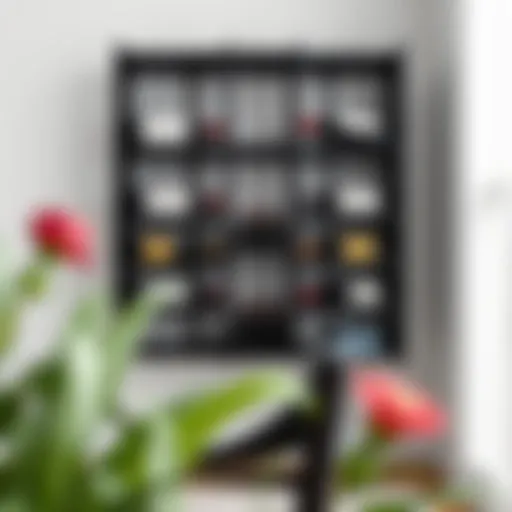Cubicle Table Tops: Design and Trends for Modern Workspaces


Intro
Cubicles often get a bad rap, seen merely as partitions separating employees in gray-walled offices. However, it’s worth looking closer at the humble cubicle table top. Far from an afterthought, it plays a significant role in shaping not just the workspace aesthetics but also how efficiently we work. The surface of your cubicle can influence mood, productivity, and even collaboration. Understanding the various designs, materials, and current trends can help both workers and managers optimize their environments for better output. In this article, we will dive into the multi-faceted world of cubicle table tops, emphasizing their importance in contemporary workspaces.
Design Trends
Current Trends in Furniture Styles
Furniture styles today are more diverse than ever, which can only benefit the function and appearance of cubicle table tops. One exciting trend is the shift towards minimalist designs. These often embody clean lines and neutral colors, promoting a sense of calm and focus. Contrast this with the retro revival movement; intricate patterns and vintage colors are making a comeback, adding character and warmth to otherwise stark environments.
Another direction sees the rise of multimedia surfaces. Some manufacturers are integrating whiteboard materials directly into the tabletop, allowing for spontaneous brainstorming sessions right at the workstation.
Sustainability is also becoming a buzzword in design. Using reclaimed wood or recycled materials demonstrates a commitment to the planet and resonates well with employees who value eco-friendly practices. These elements can be striking or understated depending on how they are utilized.
How to Incorporate Trends into Your Space
When considering how to incorporate these trends into your cubicle design, there are a few avenues to explore:
- Balance Aesthetics with Functionality: While a sleek surface may look good, make sure it serves your needs. Materials should be both stylish and practical. For instance, a table that attracts fingerprints might not be the best choice for a high-traffic area.
- Get Creative with Accessories: Sometimes even small changes, like adding a stylish desk lamp or a potted plant, can drastically improve the look and feel of a cubicle. Items such as cable organizers can also keep the space looking tidy.
- Use Color Strategically: Color psychology plays a significant role in workspace design. Shades of blue often promote focus, while greens can motivate creativity. Don’t shy away from experimenting with color to see what resonates best in your space.
Buying Guides
Choosing the Right Furniture for Different Rooms
Selecting the proper table top involves more than just picking a trendy style. Consider these factors:
- Purpose: Is this cubicle primarily for focused work, or will it be used for collaboration? Lean towards large, sturdy surfaces for shared spaces and smaller, ergonomic selections for individual ones.
- Size and Space: Make sure to measure the cubicle dimensions adequately. It’s easy to get enthusiastic and order a big table only to find that it’s too tight a fit in your cubicle.
- Material Consideration: Different materials have distinct benefits. For example, laminate finishes might be easy to clean, while solid wood can add a touch of warmth but may require more upkeep.
Tips for Assessing Quality and Value
When it comes to ensuring quality, keep these considerations in mind:
- Examine Construction: Assess whether the joints and materials are durable. The last thing you want is a wobbly table that disrupts your work.
- Check for Warranty: A good warranty can often indicate a manufacturer's confidence in their product. It shields you from defects that might arise after purchase.
- Read User Reviews: Platforms like Reddit can provide insight into how a particular product holds up over time in real-world conditions. Don’t rely solely on showroom displays; user experiences often reveal hidden drawbacks.
In summary, cubicle table tops aren't just functional; they can reflect personal style and significantly influence productivity. Understanding design trends and knowing how to select quality pieces are key to enhancing your workspace. Remember, it all starts with a well-chosen table top.
Intro to Cubicle Table Tops
Cubicle table tops are more than just flat surfaces in an office. They play a pivotal role in shaping how we work, interact, and organize our tasks. As the workplace evolves, these elements must simultaneously offer functionality and reflect the aesthetic preferences of contemporary design. There’s a growing recognition that the spaces where we spend so much of our days influence our productivity and overall job satisfaction.
Definition and Importance
A cubicle table top serves as the foundation for various activities in an office environment. It supports not only computers and paperwork, but also crucial elements like personal items and decor that make a workspace feel inviting. Their design is also important; a well-designed table top can create a seamless flow in an office, promote organization, or even enhance collaboration among teams. Ultimately, these surfaces have become a canvas where functionality meets style.
In a world that’s becoming increasingly competitive, having the right cubicle table top can be considered an investment in employee productivity and morale. A table top needs to cater not just to ergonomics but also to modern technology. Choices in surface materials, textures, and shapes can genuinely affect how employees interact with their workspace.
Historical Context
Tracing back to the roots of cubicle designs, the concept of segmented workspaces gained momentum in the mid-20th century as businesses sought methods to maximize efficiency. Initially, table tops were often just afterthoughts, largely functional and lacking in elegance. However, during the 1980s and 1990s, as open office concepts were introduced, the importance of thoughtful design in cubicle table tops started to shine through. They transitioned from mere workspace platforms to integral components that dictated work styles and interactions among colleagues.
Moreover, the rise of advancements in materials science has led to new possibilities in design, enhancing durability and aesthetics simultaneously. Ever since, designers have focused on creating cubicle table tops that meet the demands of modern technology while also catering to an evolving workforce, reflecting changing cultural attitudes toward work. It’s fascinating to see how these pieces of office furniture have not only adapted but also enriched the workspace, leading to greater efficiency and satisfaction for all involved.
With this historical transition in mind, it becomes evident that designing and selecting the right cubicle table tops is not merely a mundane task but an essential aspect of fostering a productive and harmonious work atmosphere.
Design Considerations
In the realm of cubicle table tops, design considerations play a pivotal role in shaping the functionality, culture, and aesthetic appeal of work environments. It's not just about having a flat surface to work on; it encompasses elements like shape, size, style, and how these factors contribute to the overall productivity and comfort of the workspace.
When contemplating design, one must weigh various attributes such as ergonomics, space efficiency, and personal taste. This section dissects the critical design elements that elevate cubicle table tops from simple utilitarian pieces to significant components of an inspiring office atmosphere.
Shape and Size
Rectangular Options
Rectangular table tops are the tried-and-true champions of office spaces. Their straight edges and corners provide a practical surface area for a variety of tasks. One key characteristic of rectangular options is their adaptability—ranging from compact sizes fit for smaller cubicles to expansive formats suitable for collaborative work.
These table tops often provide the most efficient space utilization, allowing for easy alignment against walls or configuration in clusters. A rectangle’s geometric regularity contributes to structured placements of technology and office supplies, fostering an organized work environment. However, they might lack the flow and engagement that other shapes offer. But if functionality is your main concern, rectangular table tops stand tall (or flat, in this case) as a beneficial choice for practical workspaces.
Round Designs
Round table tops introduce a unique dynamic to office settings. Their smooth edges promote a feeling of inclusiveness, making them a popular choice for team discussions and collaborative projects. The absence of corners allows more interaction among individuals, as everyone can see each other without barriers.
Typically, round designs come in various diameters, making them versatile for different space requirements. While they often require a larger footprint to cater to the same number of users as rectangular ones, their aesthetic appeal can transform a standard cubicle into a more inviting space. A disadvantage may arise in limited surface space, particularly if extensive equipment is involved; thus, they shine in settings prioritizing open communication over sheer utility.
Custom Sizes
When standard dimensions don’t cut the mustard, custom sizes come to the rescue. Tailoring a cubicle tabletop to fit specific measurements means reaping the benefits of optimizing the workspace to the fullest. A standout feature of custom sizes is their ability to address specific needs, such as fitting in awkward spaces or accommodating unique workflows.
Such personalization can lead to substantial improvements in efficiency and ergonomic comfort. However, the downside might be time and cost constraints, as bespoke items typically require more resources and planning. Yet for those looking to create a truly tailored workspace, the investment can pay off significantly.
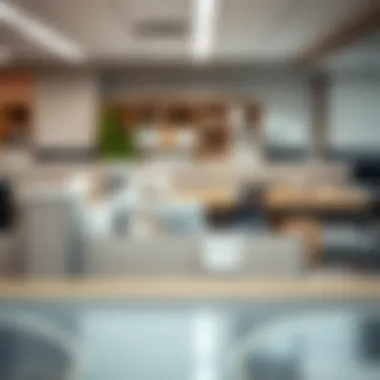
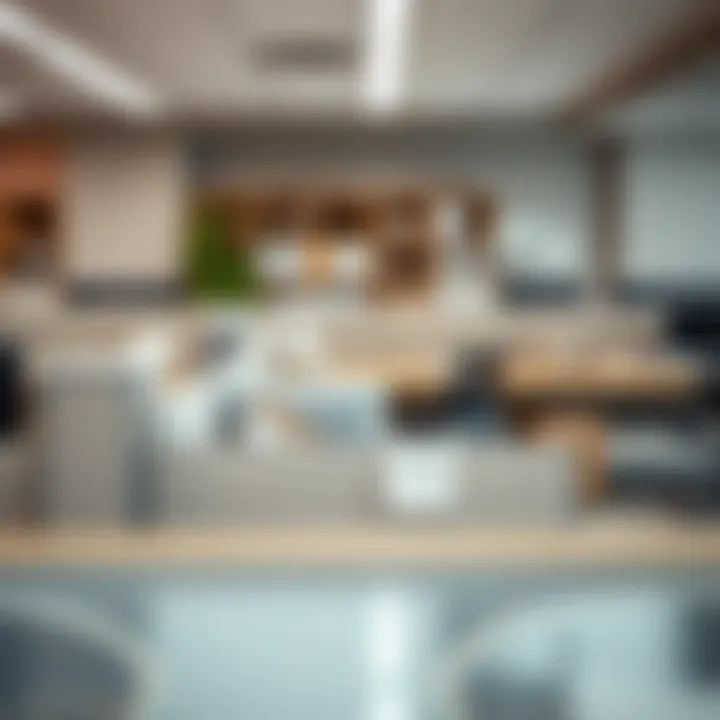
Style Variations
Modern Aesthetics
In today’s design landscape, modern aesthetics rule the roost. Characterized by clean lines, sleek surfaces, and minimal ornamentation, these table tops redefine contemporaneous office vibes. By opting for modern aesthetics, spaces can achieve a polished look that reflects technological advancement and encourages productivity.
A key aspect of modern designs is their compatibility with various materials, creating diverse visual outcomes. Notably, their simplicity might also foster ease of maintenance, enabling a pristine workspace with minimal effort. However, some may find the lack of warmth in minimalist styles a disadvantage, perhaps preferring more traditional touches.
Traditional Looks
Traditional looks evoke a sense of nostalgia and stability, drawing from timeless designs and rich finishes. Classic wooden surfaces often exhibit intricate carvings and softer contours, promoting a warm and inviting atmosphere. Choosing traditional aesthetics can communicate professionalism and reliability—a great fit for law firms or financial institutions.
This style, while appealing, may involve more intensive upkeep due to the materials and finishes involved. Additionally, some modern workplaces might see it as too staid when a more innovative vibe is adopted in their design ethos. Still, traditional looks remain a steadfast choice for spaces valuing elegance.
Minimalist Trends
Minimalism sweeps in with an ethos of less-is-more. Its defining trait lies in reducing clutter and emphasizing simplicity without sacrificing functionality. Minimalist table tops often come in soft hues with sharp geometric lines, creating a tranquil space that's easy on the eyes—and the mind.
This trend minimizes distractions, which can amplify productivity levels remarkably. However, the challenge with minimalism may surface when the design doesn't accommodate all the required tools and tech—a careful balance is needed to maintain that functional essence amidst the open space. Nonetheless, for individuals craving a serene workstation, minimalist trends certainly make a compelling case.
Material Choices
Choosing the right materials for cubicle table tops is vital in shaping both the functionality and appearance of workspaces. Material selection not only influences the aesthetic nature of office environments but also impacts durability, maintenance, and overall practicality. In modern work settings, having table tops that match the demands of daily work while also looking good is non-negotiable. Various materials offer unique pros and cons, thus making informed selections critical for designers and office managers alike.
Wood
Wooden table tops have a timeless allure that appeals to many. They're warm, inviting, and can transform a dreary office into a more comfortable space.
Solid vs. Engineered Wood
Solid wood comes from a single piece of timber, often prized for its natural beauty and unique grain patterns. It's sturdy and can last a lifetime if maintained properly. However, it might carry a heftier price tag, which can be a downside for projects on a tight budget.
On the other hand, engineered wood is created by binding wood fibers together. This type can be less expensive, and because of its manufacturing process, it's often more resistant to warping and cracking. It’s a viable option that provides a similar look to solid wood at a lower cost. However, it might lack the longevity of its solid counterpart.
In summary, while both options have their place, solid wood is often deemed a rich choice for those willing to invest, while engineered wood provides practicality for budget-conscious settings.
Finishes and Stains
Finishes and stains determine not just the appearance, but also the protection of wood table tops. A well-applied finish helps resist scratches, spills, and general wear and tear. It can enhance the natural beauty of the wood, allowing the grain and color to shine through. Moreover, stains provide an opportunity to alter the hue of the wood, giving it a more modern or traditional appearance as desired.
However, a downside is the upkeep they require; over time, finishes can wear off and may need to be reapplied. Choosing the right finish or stain is essential, as it not only beautifies but also extends the life of the piece, ensuring that the investment remains worthwhile.
Metal
Metal table tops are increasingly popular due to their sleek, modern look and high durability. They can fit seamlessly into industrial or ultra-modern office designs.
Durability and Maintenance
Metal is well-known for its resilience. It can withstand heavy use without showing much wear. For high-traffic consoles, where equipment is constantly being moved or set down, this durability is a major benefit. Maintenance is also straightforward; a quick wipe with a damp cloth typically does the job.
However, the downside is that some metals can dent if mishandled, and certain finishes may scratch more easily. It’s crucial to select the right kind of metal and protective coating to ensure longevity and optimal performance in a buzzing office environment.
Color Options
Color options for metal table tops are vast, ranging from muted tones to bold, vibrant shades. This flexibility allows for personalization in design, matching your office's color scheme or theme. The finishing techniques applied can enhance color vibrancy or create unique textures. But one must consider that not all colors are equally durable—some may fade faster than others, especially in sunlit spaces.
Glass
Glass table tops offer a trendy, open feel, making spaces appear larger and more airy. They can add a contemporary edge to any cubicle.
Safety Features
Safety is paramount with glass tops. Most modern designs use tempered glass, which is far less likely to shatter. This layering means if the glass were to break, it crumbles into small, less dangerous pieces. Opting for safety features is essential, particularly in busy work areas where accidents happen more often than one might like to admit.
However, it's still crucial to remember that glass can be prone to scratches and fingerprints, which may be a turn-off for some. Regular cleaning becomes a necessity to maintain the desired look.
Stylish Alternatives
When considering glass table tops, one can opt for various styles such as frosted, clear, or colored glass. Each style can dramatically alter the room’s vibe. Frosted glass can provide privacy while giving a soft touch that enhances elegance. While stylish, one does need to keep in mind that heavier glass pieces might need stronger support structures, which could limit specific design options.
Sustainable Materials
The growing awareness of environmental concerns makes sustainable materials an essential consideration in today’s office furniture selections. Not only do they minimize ecological footprints, but they also reflect a company's values towards sustainability.
Recycled Products
Using recycled materials for table tops showcases a commitment to environmental sustainability. These products can be surprisingly robust and come in various styles that suit many design aesthetics. The key aspect is their reduced reliance on new materials, which helps conserve natural resources. However, some recycled products may carry a higher initial cost, and the appearance can vary, which might not align with every design vision.
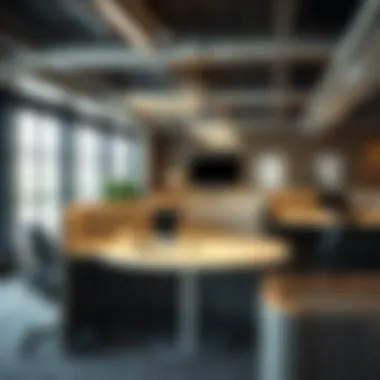
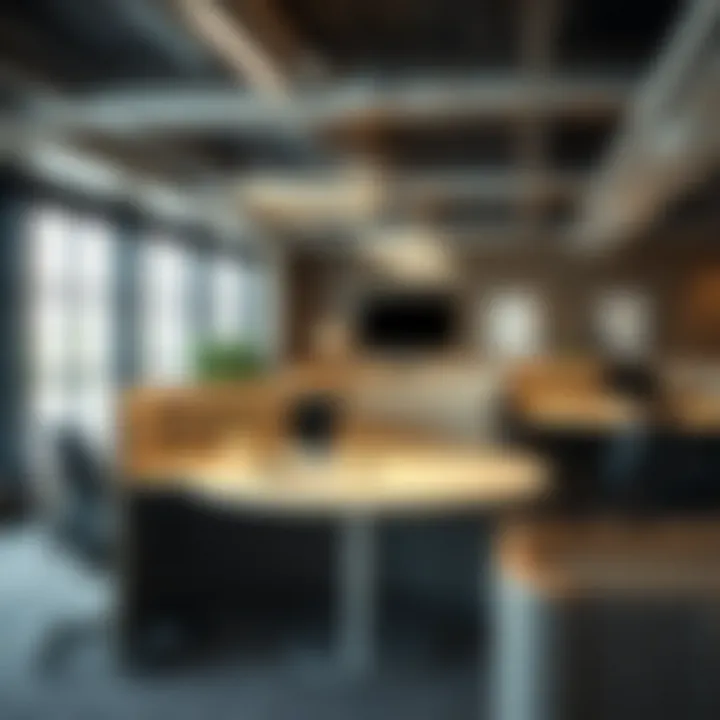
Eco-friendly Certifications
Selecting materials with eco-friendly certifications ensures that the products not only meet necessary safety standards but are also produced without harming the environment. This can transform a workplace into a beacon for sustainable practices. Products certified by recognized organizations can demonstrate a company's commitment to eco-conscious choices. However, the knowledge about these certifications can vary, and some providers may not genuinely adhere to the claimed standards, ripping off unsuspecting consumers.
Functional Aspects of Cubicle Table Tops
When contemplating cubicle table tops, their functionality surmounts mere aesthetics. These surfaces serve as the battlegrounds for productivity; they’re vital in defining how efficiently an individual can work. Not only do these elements cater to individual taste in design, but they also embrace ergonomic principles and accommodate the technological needs of a modern workspace. Potential buyers should weigh considerations such as comfort, integration of technology, and even maintenance as they forge their choices in this realm.
Ergonomics and Comfort
Height Adjustment Options
The height adjustment options of cubicle table tops stand out as a hallmark of ergonomic design. This functionality allows users to customize their workspace according to their own physical needs, promoting good posture. A desk that adjusts to both sitting and standing positions is not just a nice touch; it significantly contributes to well-being at work. People often experience fatigue, stiffness, or even long-term health issues when they’re stuck at the same height all day.
A notable trait of these adjustable desks is their mechanical ease of use. Many modern versions provide smooth transitions either via pneumatic lifts or electric systems, making them a readily popular choice. An advantage is that they enable swift adjustability without the need for excessive physical effort, allowing a seamless switching between postures. However, it’s essential to note that electric options might require regular maintenance, so one must keep that in mind.
Surface Area Considerations
Surface area comes into play as a crucial factor when examining cubicle table tops. A well-planned surface area ensures enough space for daily essentials without creating clutter. The right size can determine how effectively one can organize their workspace and execute tasks. An ample surface encourages the spread of reference materials, tech gadgets, or even personal items that foster creativity.
A widely recognized attribute of surface area is its impact on workflow. A bigger workspace allows for more items to be placed conveniently within reach, reducing distractions caused by searching for tools or documents. Yet, larger surfaces can also come with their drawbacks; they risk being overwhelming and may lead to disorganization if not managed well.
Technology Integration
Cable Management Solutions
In a world overflowing with technology, cable management solutions have made a name for themselves among essential features of cubicle table tops. These systems offer tidy arrangements for various cords, preventing them from becoming an unwieldy nest underfoot. They often include specialized conduits, clips, or even built-in cable trays that ensure everything remains tidy and accessible.
A key feature of these solutions is their ability to enhance safety by reducing trip hazards. Clients frequently find that keeping cables organized mitigates stress, as there’s no more fumbling around with tangles. Nevertheless, potential downsides might include added costs during the initial setup or periodic upkeep needed to adjust or replace broken components.
Built-in Charging Ports
As technology continues to evolve at a breakneck speed, built-in charging ports represent the fusion of electronics and furniture design. A feature that caters specifically to the demands of today’s mobile workers, charging ports embedded in cubicle table tops allow for convenient access to power sources directly at one’s workstation. This makes it easier for users to keep their devices charged without searching for an outlet.
The key characteristic of such ports is their dedicated allocation for multiple devices, which typically incorporates universal charging capabilities. It's advantageous for teams who rely on various gadgets throughout the day. However, the integration may come with a certain cost implication; higher-priced models usually offer more advanced features like rapid charging.
In summary, the functional aspects of cubicle table tops blend ergonomic features with technological integration to create an optimal workspace for productivity. A dedicated focus on these areas leads to not just aesthetic appeal but also an elevated sense of comfort, safety, and efficiency.
Current Trends in Cubicle Table Tops
Understanding the trends shaping cubicle table tops is pivotal, particularly as modern workspaces evolve. This segment will examine the latest styles, colors, and finishes that enhance both functionality and aesthetic appeal. Recognizing these trends not only informs design decisions but also optimizes the workspace for productivity and creativity. By keeping up with these shifts in style and material, homeowners, designers, and retailers can align their choices with contemporary needs while ensuring practicality. This balance is key to creating an environment that boosts morale and efficiency.
Color Trends
Color plays a crucial role in both the mood and practicality of a workspace. The latest trends regarding color choices can dictate how energized or calm a work environment feels, making it an essential focus in cubicle table top design.
Neutral Tones
Neutral tones have taken the spotlight in recent cubicle trends. These colors, ranging from soft grays to warm beiges, provide a calming backdrop that fosters a focused atmosphere. The main characteristic of neutral tones lies in their versatility; they can easily complement various interior styles without overwhelming the senses. For many designers, choosing neutral tones allows for more streamlined décor while giving potential for splashes of color in décor accessories and personal items.
One unique feature of neutral colors is that they tend to age gracefully; they don't quickly go out of style, which is a significant advantage in a workspace. This durability makes them a smart choice for those looking to invest in pieces that will still look relevant several years down the line. However, an important consideration is that while they promote a serene environment, they can sometimes risk appearing bland or uninspiring if not offset with dynamic elements or personal touches.
Bold Statements
In contrast, bold colors are also making a mark within this domain. A striking royal blue or a vibrant orange can entice creativity and spark conversation. These colors introduce an element of energization that neutral palettes often lack. The key characteristic of bold statements is, undoubtedly, their ability to capture attention and stimulate an emotional response.
The uniqueness of incorporating bold colors into cubicle designs lies in their ability to transform workspaces dramatically without needing extensive renovation. They can serve as focal points within a larger area, offering visual intrigue that encourages creative thinking. However, a drawback can be their potential to overwhelm the senses if overused or poorly matched with other elements. Thus, balance becomes essential—a little splash of boldness alongside neutral tones might just be the remedy for someone seeking an inspiring workspace.
Textured Finishes
Texture is another compelling trend that adds depth and dimension to cubicle table tops. Variations in surface finishes can influence how a space feels and interacts with light.
Matte vs. Glossy
The debate between matte and glossy finishes is alive and well when it comes to cubicle table tops. Matte finishes are often favored for their subtlety and ability to hide imperfections. They can impart a sophisticated and modern vibe, aligning well with minimalist design trends. On the other hand, glossy surfaces grab attention, reflecting light in captivating ways. They can brighten up a workspace significantly, making it seem more spacious and open.
However, while glossy finishes can indeed add a stylish edge, they may require more upkeep to maintain their luster and can be more prone to showing smudges or fingerprints. Finding the right balance involves understanding the specific use of the workspace and the personal preferences of its occupants.
Natural Textures
Natural textures, such as wood grains or stone-like finishes, have also gained ground. They provide an organic feel that connects individuals to nature, which is often lost in modern office architectures. This particular aspect encourages a soothing atmosphere, pivotal for long work hours.
Key characteristics of natural textures include their uniqueness; no two pieces are exactly the same, thus imparting a sense of individuality to each workspace. However, one must also consider the maintaining efforts involved as these materials can require specific care routines to preserve their beauty over time. In sum, opting for natural textured finishes can anchor your designs in an earthy elegance; however, it can come with added responsibilities of maintenance that might deter some designers or users.
Practical Tips for Selection
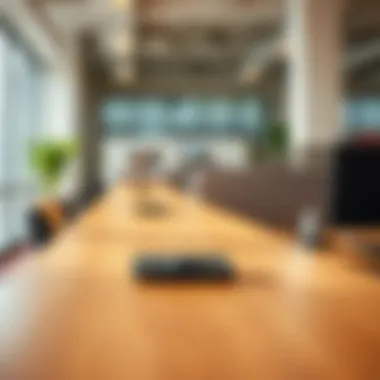
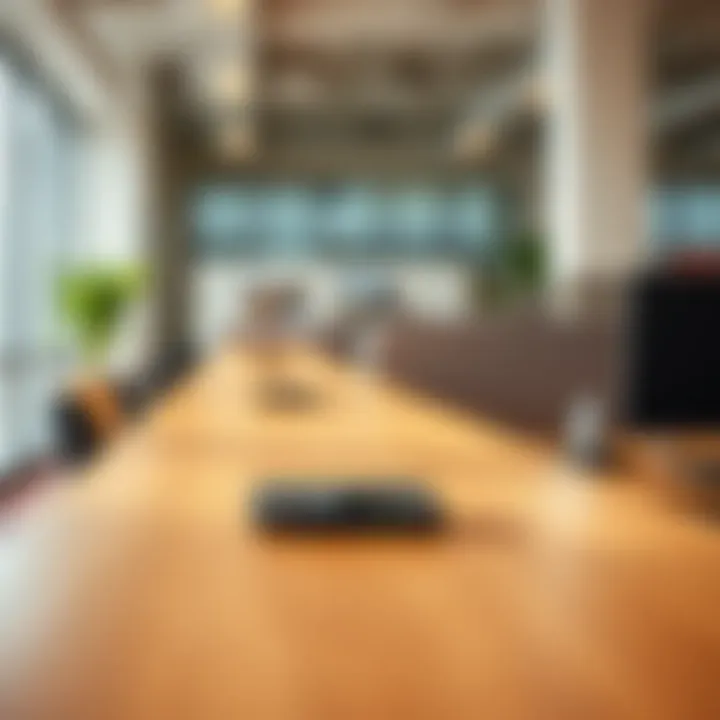
Choosing the right cubicle table top can feel like finding a needle in a haystack, with so many styles, materials, and functionalities available. However, practical tips can greatly streamlinne the decision-making process and ensure that the selected table tops complement the workspace's overall design and function. This section provides insights into how to assess your workspace, budget considerations, and most importantly, guides you through selecting table tops that meet both aesthetic and practical needs. It’s crucial to focus on function alongside form, ensuring a cohesive space that suits everyday work habits.
Assessing Workspace Needs
Evaluating Usage Patterns
Understanding usage patterns is an essential step in determining the ideal cubicle table top. Knowing how often the table will be used, the kind of tasks performed on it, and whether the workspace is shared or individual helps inform choices. For example, if the table is primarily for collaborative work, a larger surface area with a stable design will be preferable. A key characteristic of evaluating usage patterns is its adaptability; it caters to the specific requirements of each user and their work habits.
The unique feature here is that it allows organizations to create a work environment tailored to actual needs rather than assumptions. This leads to increased productivity and satisfaction among employees. However, if this evaluation is not properly conducted, there might be a risk of over or underestimating the requirements, potentially making an unsuitable choice.
Identifying Style Preferences
Style plays a significant role in the selection of cubicle table tops, as it reflects company culture and enhances the environment's overall aesthetic. Identifying style preferences involves understanding the workplace's vibe—whether it’s contemporary, rustic, or minimalist. This step ensures that the materials and designs chosen align with both personal and organizational values.
The key characteristic here is variety; style preferences can range vastly, allowing customization to cater to individual tastes while also promoting brand identity. A unique aspect of this identification process is that it encourages employees to take ownership of their workspaces, thus enhancing commitment. However, one needs to balance stylish designs with functionality, as some trending styles may not offer the durability or surface practicality needed for everyday tasks.
Budget Considerations
Choosing between high-end and affordable choices is another crucial aspect of selecting cubicle table tops. The budget dictates much of what is feasible, but it’s also important to consider long-term advantages versus short-term savings.
High-End vs. Affordable Choices
When comparing high-end and affordable options, one must carefully weigh what each brings to the table—pun intended. High-end choices often exemplify durability, aesthetics, and exclusivity. They may also come with enhanced features, such as customizable designs or eco-friendly materials. These premium options can elevate the workspace, thus creating a more inviting atmosphere. On the flip side, an affordable choice may be tempting as it allows for more flexibility in purchase decisions, especially for large office setups.
The key aspect of this comparison lies in the lifecycle costs of each option. While high-end materials may have a higher initial purchase price, their durability can lead to reduced replacement costs over time. Conversely, affordable choices may require more frequent replacements and therefore can add up in the long run.
Long-term Value Assessment
A long-term value assessment is critical in guiding your final decision. Evaluating potential table tops not just for their immediate cost but their expected lifespan and upkeep is vital. Good quality materials can save money over time by requiring less maintenance and providing longer service.
Key characteristics include overall design integrity, along with strengths in wear resistance. One unique feature in this evaluation is how a cube design might accommodate technology integration, such as built-in chargers or cable management options, contributing to greater functionality. This adds practical value beyond mere aesthetics. Neglecting this assessment might lead to higher replacement costs down the line, undermining budget considerations.
Ultimately, by focusing on evaluating workspace needs and aligning them with budget considerations, one can make informed choices in selecting cubicle table tops that offer both aesthetic appeal and functional longevity.
Maintenance and Care
Maintaining cubicle table tops is crucial for preserving their aesthetic appeal and functional performance. Proper care not only extends the lifespan of these surfaces but also contributes to a healthier work environment. Dust, spills, and scratches can diminish both the look and utility over time, leading to potential productivity losses. Therefore, inculcating a habit of regular maintenance can be invaluable for office users of any kind, from homeowners to large corporations.
Cleaning Techniques
Surface-Specific Best Practices
Cleaning cubicle table tops requires a tailored approach depending on the surface material. For instance, wood requires gentle cleaning methods to prevent damage to its finish, while metal surfaces can endure more robust cleaning products. Using a soft cloth with a wood cleaner is often the best choice for wooden surfaces, as it helps in maintaining the sheen without causing scratches.
On the other hand, metal desks might benefit from mild soap and water or a dedicated metal cleaner, which can effectively lift grime without scratching the surface. The key characteristic of these tailored cleaning methods is their ability to preserve the integrity of the material while ensuring cleanliness. Failure to use the proper cleaning agents can lead to unsightly damage or finish deterioration, which in the long run, may require costly replacements.
Removing Stains
Stains can happen in the blink of an eye, whether from coffee spills or ink marks. Addressing them promptly is vital. Different materials have unique needs; for instance, glass tops might just need a glass cleaner to restore their shine, while stained wood may require gentle scrubbing with a soft brush and soapy water.
One of the most beneficial aspects of effective stain removal techniques is that they help retain the cubicle’s professional appearance, underpinning the workspace's overall aesthetic. However, it's worth noting that aggressive cleaning methods can lead to further damage. Always test on an inconspicuous area first to ensure no unwanted marks are left behind.
Longevity Enhancements
Protective Coatings
Applying protective coatings is one way to amplify durability. These coatings serve as a shield against scratches, spills, and other wear issues. For example, many modern workplaces opt for clear polyurethane finishes on wooden cubicle tops. This coating provides an added layer of protection without altering the wood's natural appearance.
One unique feature of protective coatings is their versatility; they can be used on various materials, enhancing their lifespan significantly. The main advantage lies in reduced maintenance; surfaces treated with protective coatings often require less frequent cleaning, thus saving time and effort.
Regular Inspections
Cultivating a habit of regular inspections of cubicle table tops can spot minor issues before they escalate into major problems. This means checking for wobbliness, scratches, or any signs of wear. Regular inspections help maintain the structural integrity of the furniture and ensure safety in daily use.
The key characteristic of this proactive approach is its ability to catch issues early, ultimately leading to longer-lasting furniture. While some might see inspections as tedious, they are beneficial in catching small problems before they become big headaches, offering a smart investment in maintaining office furnishings.
Closure
In wrapping up this exploration into cubicle table tops, it becomes clear that these surfaces are more than mere functional items—they are essential components that significantly affect both the aesthetics and productivity of modern workspaces. Choosing the right cubicle table top requires a nuanced understanding of design principles, material properties, and user needs. Each selection contributes to the overall atmosphere of the office, either fostering collaboration or providing a serene environment for focused tasks.
Summarizing Key Points
To encapsulate our discussion, consider these pivotal aspects:
- Design Matters: From shape and size to style, the visual aspect of table tops cannot be underestimated in influencing workplace dynamics.
- Materials Influence Performance: Proper material selection not only impacts durability but also defines the maintenance routine required to keep surfaces presentable and functional.
- Functionality Features: Ergonomics and tech integration enhance daily usability, making it crucial for individuals to assess their particular requirements before committing to a purchase.
- Trends Shape Choices: Staying updated on current trends—whether in color or finish—can aid designers and office managers in making informed decisions that resonate with the evolving nature of workplace environments.
- Care Ensures Longevity: Understanding how to properly maintain cubicle table tops extends their life and retains their value, making it imperative for users to adopt selected cleaning and care routines.
Future Perspectives
Looking ahead, the evolution of cubicle table tops will likely reflect broader shifts in work culture and technological advancements. Key trends to watch for include:
- Increased Demand for Sustainability: As businesses prioritize eco-friendly practices, incorporating sustainable materials will gain traction in workspace design. This might mean switching to recycled materials or finishes that lower environmental impact.
- Smart Table Tops: With technology increasingly integrated into everyday objects, future cubicle table tops are expected to feature built-in connectivity options, ambient lighting, and adjustable functionalities to cater to present-day work dynamics.
- Flexible Designs: The rise of hybrid work environments suggests a future where adaptability is key. Table tops that easily transition between configurations will likely become the norm.
- Health-Conscious Features: As awareness of health and wellness grows, ergonomic designs that promote better posture and overall comfort will take precedence, leading to more innovative solutions in table top construction.
Ultimately, as work continues to evolve, so will the designs and functionalities of cubicle table tops. Engaging with these changes not only optimizes workspace efficiency but also creates environments that inspire and nurture the work family.







